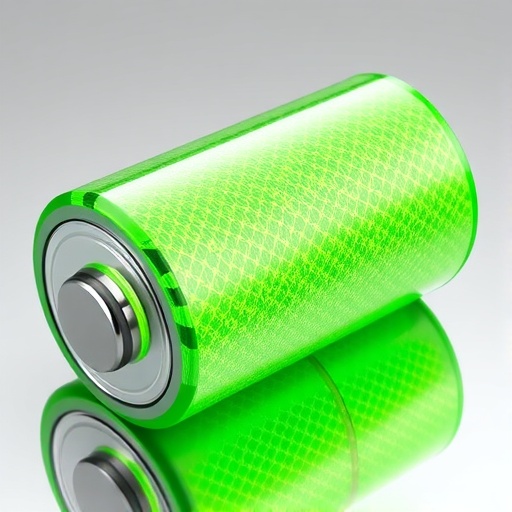Recent advancements in lithium-ion battery technology continue to revolutionize the field of energy storage, a key aspect of the global shift towards sustainable energy sources. A cutting-edge study published by Wang et al. delves into the innovative design of anodes using Co₃O₄/MnMoO₄ nanorod clusters, enhanced through surface modifications. This research not only promises to improve the efficiency of lithium-ion batteries but also addresses fundamental challenges still present in battery engineering today. With the world increasingly relying on battery-powered devices, this endeavor is timely and crucial.
The focal point of this study is the integration of cobalt oxide (Co₃O₄) and manganese molybdate (MnMoO₄) into nanorod clusters. These nanostructured materials possess unique electrical properties that make them highly suitable for battery applications. Specifically, their large surface area and increased conductivity offer significant advantages over traditional anode materials. In addition, by clustering these nanorods, researchers can maximize their electrochemical performance, pushing the boundaries of what current lithium-ion batteries can achieve.
Surface modification plays a pivotal role in enhancing the performance of the Co₃O₄/MnMoO₄ nanorod clusters. Wang and his team employed various techniques to optimize the surface characteristics of the nanomaterials, ensuring superior charge transfer rates and electrochemical stability. This modification process is not merely an enhancement but a crucial step for improving the longevity and effectiveness of the anodes. By carefully tailoring the surface properties, the research further illustrates how nanostructuring can lead to significant gains in battery efficiency.
The implications of this research extend beyond theoretical applications. As our need for high-performance batteries grows alongside the demand for electric vehicles and renewable energy systems, enhancing the electrochemical properties of battery materials is essential. The findings provide insights that could assist in the development of batteries with higher capacities and faster charging abilities, essential metrics for consumer satisfaction and market competitiveness. Thus, the contributions of this research may well shape the future of energy storage technology.
Moreover, the environmental benefits associated with these advancements cannot be overstated. The transition to more efficient battery systems ultimately aims to reduce our reliance on fossil fuels, promoting cleaner energy sources. By improving the clinical utility of lithium-ion batteries, Wang et al. contribute positively to environmental sustainability efforts. Their findings underscore the importance of pursuing innovations that not only meet performance demands but also align with ecological considerations.
The study emphasizes a variety of experimental methods to evaluate the performance of the proposed anodes. A series of electrochemical tests, including cyclic voltammetry and galvanostatic charge-discharge measurements, were employed to gauge the efficiency and stability of the Co₃O₄/MnMoO₄ nanorod clusters. These rigorous testing protocols validate the technological promise of the proposed anodes, ultimately showcasing how empirical evidence supports theoretical models of battery behavior.
Future directions indicated by the study suggest that researchers may explore even more complex hybrid structures to build upon the foundation of the current findings. By examining other combinations of materials and modifying their properties, scientists hope to unearth even greater performance enhancements. The iterative nature of this research process epitomizes the dynamic landscape of battery technology, where continuous innovation is key to remaining at the forefront of advancements.
It is also noteworthy that the collaboration amongst the researchers reflects a growing trend in multidisciplinary approaches. By combining insights from materials science, electrochemistry, and engineering, the study illuminates how collaborative frameworks can generate novel solutions. Such interdisciplinary cooperation is essential for tackling the intricate challenges faced in the development of new energy storage technologies.
Within the broader context of battery technology, the results of this study align with ongoing efforts globally to enhance energy efficiency and sustainable practices. As the race to develop superior batteries continues, research like this serves as a catalyst for industry change, pushing standards for performance and reliability ever higher. The synergy between academic research and real-world applications is more critical than ever, as industries seek reliable partners in advancing battery technologies.
With an eye towards commercialization, the research not only explores scientific possibilities but also raises important questions about scalability and manufacturing practices. Transitioning breakthroughs from the lab to production facilities poses significant challenges that need to be addressed. Ensuring that these nanorod clusters can be produced at a competitive cost without compromising their advanced features will be crucial for widespread adoption.
As society increasingly depends on battery-powered solutions, the insights provided by Wang et al. highlight the importance of innovative research in shaping the next generation of energy technologies. Their work exemplifies how eclectic approaches to materials engineering can lead to substantial advancements in resilience and performance.
In summary, as we venture further into an electrified world, the significance of the Co₃O₄/MnMoO₄ nanorod clusters described in this research will undoubtedly resonate within both scientific and commercial spheres. Wang and his co-authors have successfully illuminated a potentially game-changing avenue for energy storage, marking a significant step forward in the relentless pursuit of greater efficiencies in lithium-ion batteries.
As researchers continue to explore and iterate on these discoveries, the overarching goal remains clear: to harness groundbreaking innovations that not only meet current demand but also contribute to a sustainable future. The study stands as a remarkable example of how forward-thinking research can bridge the gap between concept and application, ushering in a new era of battery technology poised to meet the challenges of tomorrow.
Subject of Research: Development of Co₃O₄/MnMoO₄ nanorod clusters as anodes for lithium-ion batteries.
Article Title: Co₃O₄/MnMoO₄ nanorod clusters with surface-modified heterostructures as anodes for lithium-ion batteries.
Article References: Wang, Y., Fu, L., Zheng, G. et al. Co3O4/MnMoO4 nanorod clusters with surface-modified heterostructures as anodes for lithium-ion batteries. Ionics (2025). https://doi.org/10.1007/s11581-025-06764-6
Image Credits: AI Generated
DOI: https://doi.org/10.1007/s11581-025-06764-6
Keywords: Lithium-ion batteries, Co₃O₄, MnMoO₄, energy storage, nanorods, electrochemical performance, surface modification, sustainable energy.




